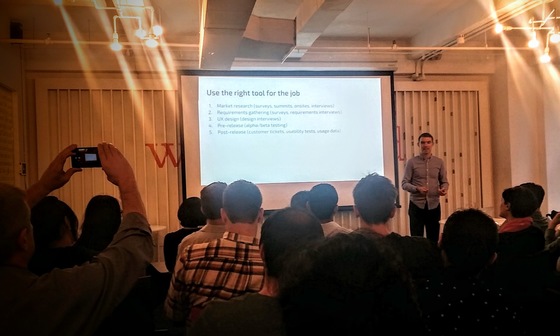With Product Management Interviews, You Must Listen 90% of the Time
By Dennis Clemente
NEW YORK—At the Product School last August 3, Marty Cagan presented an hour-long talk on product management and the importance of managing new products and features of your startup using a customer delivery toolkit, which includes one important body part – your ear.
“You should be listening 90 percent of the call,” he said, referring to how you let interviewees talk as you hand out questions the rest of it.
But to start, he suggests doing customer research/survey as your build new products:
- Understand the market, competitors, user personas and processes
- Create a prioritized list of user stories, iterate on designs
- Look at impressive existing products
Take these steps, he suggests:
- Do a survey. Gather general info about a customer problem and source interviewees, citing how this is fast and scalable (1 hour investment of your time plus get customer response); fun and easy for customers, if you design it right; and everything is recorded and standardized.
The downsides: It’s not good for capturing nuance and details, you will miss unknown unknowns and you can’t drill down into critical areas.
The best practices: keep it short, minimize typing and test on a few internal folks and customers
- Do requirements interviews: Get a deeper understanding. Understand user personas, processes
Pros: Captures details and nuances; easier to discover unknown issues/ideas and dig further; develops the customer relationships (for design interviews)
Cons: Takes time (1 hour investment/customer response)
Low sample size (max 5 to 10 interviews per feature)
Best practices:
- Interview your smartest customers and prospects
- Send a good pitch email
- Do a screen share (join.me, hangout)
- Ask to record it
- Send questions, document in advance
- Let the interviewee go off on tangent, if worthwhile
- Ask if they want to participate interview
- Once that calls become repetitive, you’re done
Ask good questions
- Ask broad questions first, then get more narrow
- Embrace awkward pauses
- Don’t lead the witness
- Listen 90 percent of the time
Expand the format
- Show versus tell
- Make it interactive
Get some amazing outputs like “a day in the life” description; a flow chart showing current process and variants; prioritizing list of user stories – top ones are your MVP
3. Design interviews. Present design ideas to the user, get input, keep iterating until satisfied
- Work with a designer to create one or more prototypes
- Jump on a call and have the user walk through the prototype
- Iterate based on their feedback
- When changes start become less frequent, you’re done
- Can also email prototypes to get feedback more quickly
Best practices
- Have both PM and designer on the call
- Get highest fidelity prototype with lowest effort
- Don’t explain your design, let the user muddle though
- Don’t argue over design
- Act on feedback, don’t be stubborn
4. Do customer visits
Get out and visit customers where they use your product
Pros: Get the full customer context, tech, processes, personalities, capabilities; gather tons of photos, videos, and competitive research. The downsides? Lots of time (5-hour investment/customer response); can be costly and is a low sample size.
Best practices:
- Block a few days and bath visits to multiple customers
- Send agenda in advance
- Have multiple interview Q&As and/or design prototypes ready
- If B2B, make sure the right customer stakeholders attend
- Record as much as possible (with presentation)
5. Do customer summits. Get a group of 5 to 8 sharp customers together and dig into a range of issues.
Pros
- Fun and inspirational for everyone involved
- Ideas build on each other to unlock new insights
- Best tool for building relationship
Cons
- A lot f time (8-hour investment/customer response)
- A lot of money ($1 K/customer to book venue, possibly flying them in
- Low sample size
Best practices
- Easier if customers are local
- Keep it to 5 to 8 smart representative customers
- Prepare exercises well (ex. design breakout sessions)
- Use for brainstorming, requirements gathering, and design
- Make sure others in their organization get customer exposure
It’s important to use the right tools and activities for the job:
- Market research (surveys, summits, interviews
- Requirements fathering (surveys, requirements interviews)
- UX design (design interviews)
- Pre-release (alpha/beta testing)
- Post-release (customer tickets, usability tests, usage data)
Make time for customer research:
- Worst. You respond ad hoc to your gut-feel ideas, customer request and bug filings
- Absolute minimum. Do proactive interviews, analyzing usage data and examining customer tickets before deciding what to do
- Basic. The above, plus some onsite visits quarterly NPS score surveys, and occasional discovery surveys
- Advanced. The above plus frequent focus groups, on sites and competitive walkthroughs. And you use all of the tools well and adopt the latest tech.
If you forget everything else, here are some more tips:
- Gather requirements before design testing
- Prepare hard for interviews, mostly listen, and use visuals
- Document and share insights with the whole company
Individual customer’s input is one data point. You can choose to ignore it. But when the data lines up, act on it. As for the elephant the room; that is, how do you get people to do the survey with you? Do a good pitch in your email and best of all, give a gift card.
